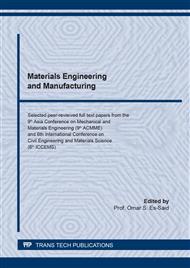p.50
p.57
p.62
p.68
p.74
p.85
p.90
p.97
p.103
Study the Surface and Chip Formation of Wood Materials by Milling Method
Abstract:
This paper discusses the experimental study and the mechanism of chip formation, sliding and cutting in processing wood milling surface. The main objective is to determine chip thickness upon the coefficient k and tool tip radius ρ. Technically, when analysing we use FCCCD's second-order response surfaces method and analysis of variance (ANOVA) for determining the coefficient k upon the factors of milling cutter diameter D, the feeding per tooth Sz and tool tip radius ρ. According to the obtained experimental results, we determined the value domain of the machine's working factors so that the cutter tool tip can slide or cut the chip on the milled surface of tropical wood materials. From the coefficient k, we can determine the slide length Lsl which gives reason for the abrasion phenomenon of the front or rear sides of the cutter. The results allow us to choose the geometrical parameters for milling cutter, apart from the working parameters for processing the surface of wood materials with the highest quality as possible.
Info:
Periodical:
Pages:
74-81
Citation:
Online since:
October 2021
Authors:
Keywords:
Price:
Сopyright:
© 2021 Trans Tech Publications Ltd. All Rights Reserved
Share:
Citation:


